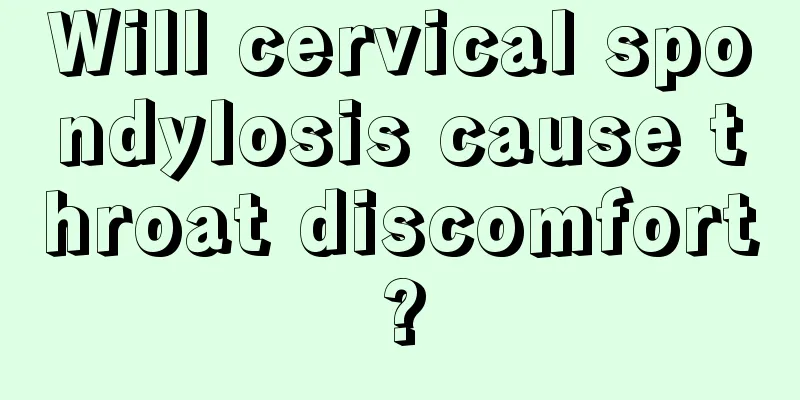Will cervical spondylosis cause throat discomfort?

|
The cervical spine is a relatively important part of the human body. It not only bears the weight of the head, but also has a relatively large range of motion. Many people with cervical spondylosis experience dizziness, headaches, and vision loss, mainly because the bone spurs on the vertebrae can easily stimulate or compress the vertebral artery. So can cervical spondylosis cause throat discomfort? Can cervical spondylosis cause throat discomfort? Foreign body sensation in the pharynx and swallowing difficulties are symptoms of pharyngeal sensory and motor dysfunction, which can be induced by any lesions of the pharynx and adjacent tissues and organs or various stimulations of the pharyngeal nerves. Among them, the osteophytes on the front edge of the cervical vertebrae compress and irritate the esophagus, causing dysphagia and swallowing disorders, which is called esophageal compression type cervical spondylosis. Due to the lack of knowledge or consideration of this disease by non-professional doctors, the misdiagnosis rate of this disease is as high as 75%-85%, and it is often misdiagnosed as two extreme diseases, such as cancer and neurosis, thus causing unnecessary mental burden on patients. (I) Etiology and pathology 1. There are two mechanisms for the formation of beak-shaped osteophytes on the anterior edge of the vertebral body: (1) Acute extension trauma of the cervical spine causes acute cervical disc protrusion, resulting in acute severe tear of the anterior longitudinal ligament, and the nucleus pulposus protrudes to the front of the vertebral body, where a mixed hematoma and nucleus pulposus protrusion are formed, which then undergoes organization and calcification and finally forms a hard osteophyte. In addition to large osteophytes in front of the vertebral body, these patients must also have significantly narrowed intervertebral space or complete disappearance of the intervertebral space, and the symptoms appear quickly and are obvious. (2) Although chronic or subacute extension trauma, strain, and cervical disc herniation may also cause damaged bulge or even tear of the anterior longitudinal ligament, there is no obvious protrusion of the nucleus pulposus and osteophyte formation is very slow. The osteophytes of these patients are small and blunt, generally not accompanied by severe narrowing of the intervertebral disc, and the symptoms appear slowly and are not obvious. 2. Cervicogenic dysphagia is related to the following factors: (1) The cervical sympathetic nerves are stimulated and compressed, which affects the tension of the swallowing muscles and the secretion of the mucosal glands, resulting in a foreign body sensation in the throat and dysphagia. (2) Lesions in the cervical spine stimulate and compress the cervical sympathetic nerves and vertebral arteries, causing insufficient blood supply to the vertebral-basilar artery system and blood circulation disorders in the posterior cranial fossa nerve nucleus, resulting in sensory and motor dysfunction in the pharyngeal tissues innervated by the 5th, 9th, and 10th cranial nerves, thus producing symptoms. (3) The traumatic inflammatory response of the cervical vertebrae and soft tissues reflexively causes protective spasm of the neck muscles, stretching and compressing the anterior cervical tissues and producing pharyngeal symptoms. (4) Linear compression and irritation from anterior slip of the cervical vertebrae or giant osteophytes. 2. Clinical manifestations Because the connective tissue in front of the vertebral body is relatively loose, the esophagus has good elasticity and its buffer space is relatively large, although osteophytes in front of the vertebral body are very common, they are mostly asymptomatic. Dysphagia will only occur when the length of the osteophytes reaches a certain extent and exceeds the compensatory capacity of the esophagus. The clinical features are as follows: 1. The degree of dysphagia in most patients is proportional to the size of the osteophytes, but some patients have larger osteophytes but no obvious symptoms, while others have smaller osteophytes but obvious symptoms. 2. Dysphagia is obviously relieved by lowering the head when the head is tilted back, because lowering the head and flexing the neck can relieve the pressure of bone spurs on the esophagus. 3. Dysphagia is obviously related to the location of osteophytes, that is, it is related to the compressed segment of the esophagus. The esophagus located at the C6 plane is affected by the cricoid cartilage, and the esophagus is less active. Smaller osteophytes in this part can also cause symptoms. The esophagus in other parts has greater mobility, and small osteophytes are less likely to cause swallowing obstruction. 4. Dysphagia is paroxysmal and can be relieved or disappear naturally, which shows that dysphagia is multi-sourced. Osteophyte is not the only factor, and it is closely related to mental stress, inflammation and autonomic dysfunction. If the osteophyte is located above C4 (common), the main symptom is a foreign body sensation in the pharynx. 5. Patients with esophageal compression type of cervical spondylosis may have symptoms of cerebrovascular and cardiovascular autonomic dysfunction such as dizziness, headache, insomnia, tinnitus, blurred vision, irritability, chest tightness, and palpitations. 6. Symptoms of cervical spondylosis such as neck and back pain. (III) Key points of diagnosis 1. There is a foreign body sensation in the throat or swallowing difficulties. Swallowing disorders have three main characteristics: painless, recurrent attacks and natural relief. No space-occupying lesions were found on esophageal barium radioscopy. 2. Middle-aged or elderly people with symptoms of cervical spondylosis. 3. Palpation: tense cervical muscles, asymmetry of cervical 4-6 articular processes, skewed spinous processes, and tenderness. There are nodules, tension, and tenderness in the middle and posterior scalene muscles. Lateral flexion of the neck is limited. There is back pain when bending forward, but rotation is mostly fine. 4. X-ray examination: There are bird-beak-shaped osteophytes on the front edge of the cervical vertebrae. Typically, the osteophytes are centered on the intervertebral space, and the upper and lower osteophytes are in opposite directions, with the osteophytes on the upper vertebra pointing downward and the osteophytes on the lower vertebra pointing forward and upward. Osteophytes vary in length, with the longest reaching 1-1.5cm and the shortest being less than 0.5cm. Vertebral osteophytes are most prominent at the anterior edge of C4-6. The spinous processes of C4-6 are scoliotic or rotated left and right, and the uncovertebral joints are hypertrophic. The line connecting the posterior edges of the vertebral bodies becomes straight, hyperextensive, angulated or interrupted, the vertebral bodies show bilateral or biprotrusive signs, and the intervertebral space becomes narrower. (IV) Dietary taboos The sensation of foreign body in the throat is often related to emotions, so do not talk about unpleasant things or drink alcohol to keep yourself depressed. Eliminate the "cancer fear" mentality and do not take so-called "anti-cancer" foods indiscriminately. Eat more foods that can calm the nerves and relieve shock, such as Monkey mushrooms, lotus seeds, fresh lilies, wild jujube kernels, milk, etc. Be careful when eating hot foods, such as lamb, beef, venison, etc. |
<<: Is cervical spondylosis prone to occur in summer?
>>: What is the cause of cervical vertebra dislocation
Recommend
There was a sudden rumbling sound in my ears
The guidance for diagnosing the cause of tinnitus...
Will there be recurrence after radiotherapy
After getting cancer, the first thing that comes ...
What tests can be done to confirm malignant hamartoma
What tests can be done to confirm malignant hamar...
What are the methods of using egg mask to remove blackheads
Some people have blackheads due to various reason...
Can congenital facial paralysis be cured?
Facial paralysis is a neurological skin disease t...
Special Chinese medicine treatment for colorectal cancer patients
Traditional Chinese medicine believes that colore...
What are the treatments for advanced nasopharyngeal carcinoma?
What are the treatments for advanced nasopharynge...
Seborrheic dermatitis on both sides of the nose
Seborrheic dermatitis is a common and frequently ...
Radical prostatectomy for patients with early prostate cancer
If prostate cancer is detected in its early stage...
Nursing measures for colon cancer
There are many taboos for patients with colon can...
Which one should I use first, foundation or air cushion?
Foundation and air cushion bb are actually the sa...
Is tea really effective in removing blackheads?
Most people think that tea has no other uses exce...
How to remove ink from clothes
Children nowadays often come home covered in ink....
What to do if bladder cancer recurs? Three ways to deal with recurrent bladder cancer
Bladder cancer is very common among urinary tumor...
Symptoms of esophageal cancer recurrence
Patients may experience recurrence after esophage...









